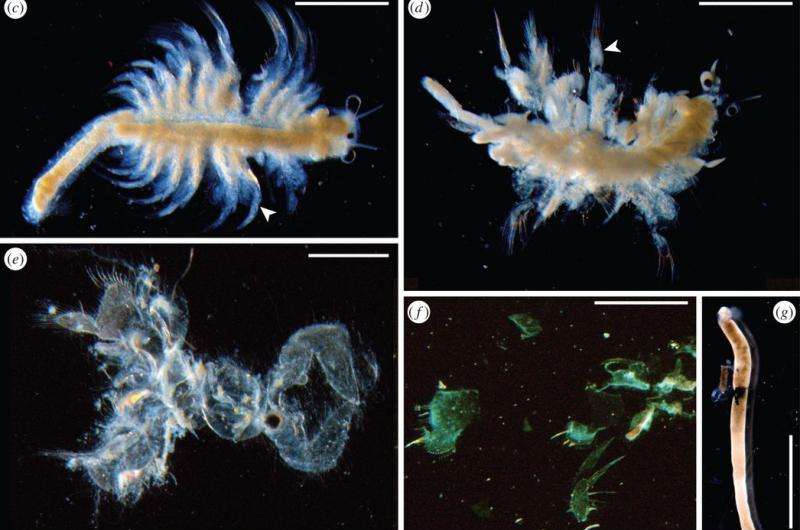May 13, 2015 report
New evidence helps explain why some soft tissue fossilizes better than others

(Phys.org)—A small team of researchers with the University of Bristol in the UK and another with Uppsala University in Sweden has found a reason for why soft tissue in some species fossilizes better than others. In their paper published in Proceedings of the Royal Society B, Aodhán Butler, John Cunningham, Graham Budd and Philip Donoghue describe a study they carried out that involved analyzing how a type of shrimp decays.
For many years scientists have debated whether the "Cambrian Explosion" was the result of more species suddenly developing or whether it was just the result of more remains being fossilized and found. In this new effort, the researchers suggest it might have had to do with the development of the anus and a through-gut.
Finding soft tissue fossils is rare, and when it does occur, the fossils are typically only small portions of the deceased organism, and more often than not, those pieces were once a part of a digestive system. Why this is has not been well studied the team noted, so they decided to look into it. To learn more they studied the process by which brine shrimp decay—the little creatures are nearly transparent, thus it was possible to watch the bacteria inside of them go to work after the shrimp died.
In watching the process of decomposition, the team noted that bacteria in the gut set to work right away, multiplying massively as they engaged in eating the dead tissue around them, so much so that they completely filled the cavity and eventually caused it to burst, which gave them access to other internal organs. If the shrimp was in a low oxygen environment when it died, such as being buried in sand, then most of the decomposition occurred from the inside, and then stopped as the bacteria ran out of air. But, because gut bacteria carry a lot of calcium and/or phosphates and because they form biofilms, after they died, they left behind a mold of sorts that showed the form of the gut organs of their dead host.
The researchers believe that it was the mold left behind by gut bacteria that is actually what is found with soft tissue fossils, and thus, it appears a possibility that part of the "Cambrian Explosion" was due to the development of an anus and through-gut—because they harbor much more gut bacteria.
More information: Experimental taphonomy of Artemia reveals the role of endogenous microbes in mediating decay and fossilization, Proceedings of the Royal Society B, DOI: 10.1098/rspb.2015.0476
Abstract
Exceptionally preserved fossils provide major insights into the evolutionary history of life. Microbial activity is thought to play a pivotal role in both the decay of organisms and the preservation of soft tissue in the fossil record, though this has been the subject of very little experimental investigation. To remedy this, we undertook an experimental study of the decay of the brine shrimp Artemia, examining the roles of autolysis, microbial activity, oxygen diffusion and reducing conditions. Our findings indicate that endogenous gut bacteria are the main factor controlling decay. Following gut wall rupture, but prior to cuticle failure, gut-derived microbes spread into the body cavity, consuming tissues and forming biofilms capable of mediating authigenic mineralization, that pseudomorph tissues and structures such as limbs and the haemocoel. These observations explain patterns observed in exceptionally preserved fossil arthropods. For example, guts are preserved relatively frequently, while preservation of other internal anatomy is rare. They also suggest that gut-derived microbes play a key role in the preservation of internal anatomy and that differential preservation between exceptional deposits might be because of factors that control autolysis and microbial activity. The findings also suggest that the evolution of a through gut and its bacterial microflora increased the potential for exceptional fossil preservation in bilaterians, providing one explanation for the extreme rarity of internal preservation in those animals that lack a through gut.
Journal information: Proceedings of the Royal Society B
© 2015 Phys.org



















